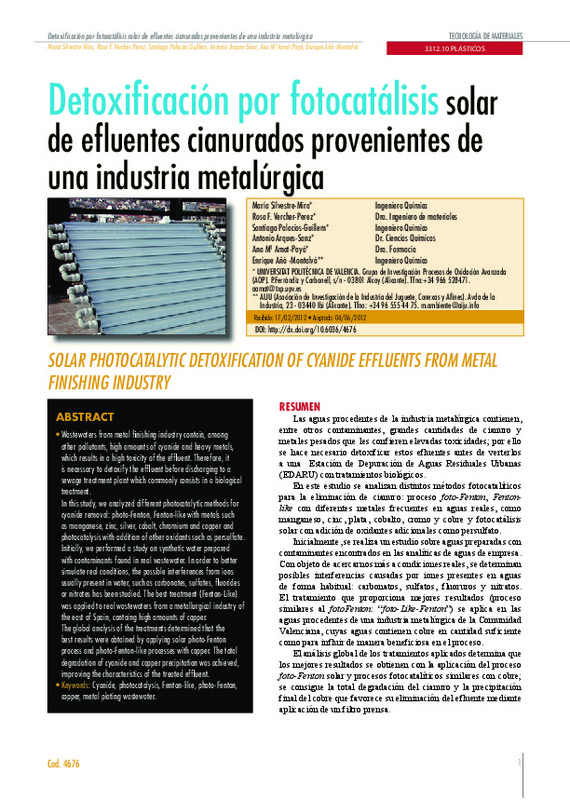|
Resumen:
|
[En] Wastewaters from metal fi nishing industry contain, among
other pollutants, high amounts of cyanide and heavy metals,
which results in a high toxicity of the effl uent. Therefore, it
is necessary to detoxify the ...[+]
[En] Wastewaters from metal fi nishing industry contain, among
other pollutants, high amounts of cyanide and heavy metals,
which results in a high toxicity of the effl uent. Therefore, it
is necessary to detoxify the effl uent before discharging to a
sewage treatment plant which commonly consists in a biological
treatment.
In this study, we analyzed different photocatalytic methods for
cyanide removal: photo-Fenton, Fenton-like with metals such
as manganese, zinc, silver, cobalt, chromium and copper and
photocatalysis with addition of other oxidants such as persulfate.
Initially, we performed a study on synthetic water prepared
with contaminants found in real wastewater. In order to better
simulate real conditions, the possible interferences from ions
usually present in water, such as carbonates, sulfates, fl uorides
or nitrates has been studied. The best treatment (Fenton-Like)
was applied to real wastewaters from a metallurgical industry of
the east of Spain, containg high amounts of copper.
The global analysis of the treatments determined that the
best results were obtained by applying solar photo-Fenton
process and photo-Fenton-like processes with copper. The total
degradation of cyanide and copper precipitation was achieved,
improving the characteristics of the treated effl uent.
[-]
[ES] Las aguas procedentes de la industria metalúrgica contienen,
entre otros contaminantes, grandes cantidades de cianuro y
metales pesados que les confieren elevadas toxicidades; por ello
se hace necesario detoxificar ...[+]
[ES] Las aguas procedentes de la industria metalúrgica contienen,
entre otros contaminantes, grandes cantidades de cianuro y
metales pesados que les confieren elevadas toxicidades; por ello
se hace necesario detoxificar estos efluentes antes de verterlos
a una Estación de Depuración de Aguas Residuales Urbanas
(EDARU) con tratamientos biológicos.
En este estudio se analizan distintos métodos fotocatalíticos
para la eliminación de cianuro: proceso foto-Fenton, Fentonlike
con diferentes metales frecuentes en aguas reales, como
manganeso, cinc, plata, cobalto, cromo y cobre y fotocatálisis
solar con adición de oxidantes adicionales como persulfato.
Inicialmente, se realiza un estudio sobre aguas preparadas con
contaminantes encontrados en las analíticas de aguas de empresa.
Con objeto de acercarnos más a condiciones reales, se determinan
posibles interferencias causadas por iones presentes en aguas
de forma habitual: carbonatos, sulfatos, fluoruros y nitratos.
El tratamiento que proporciona mejores resultados (proceso
similares al fotoFenton: ¿foto-Like-Fenton¿) se aplica en las
aguas procedentes de una industria metalúrgica de la Comunidad
Valenciana, cuyas aguas contienen cobre en cantidad suficiente
como para influir de manera beneficiosa en el proceso.
El análisis global de los tratamientos aplicados determina que
los mejores resultados se obtienen con la aplicación del proceso
foto-Fenton solar y procesos fotocatalíticos similares con cobre;
se consigue la total degradación del cianuro y la precipitación
final del cobre que favorece su eliminación del efluente mediante
aplicación de un filtro prensa.
[-]
|









